Maintenance Check. Automated Quality Check.
Project for Gemeente Delft.
Together with: Michal Maciejewski, Marcin Chmielowski and Hector Ruiz
Sprint 1
Definition of Done
1. The drone is safe, legal and usable for checks
2. The solution makes checks easier, cheaper and more effective
3. The workers find the tool easy and more fun
4. We make mommies proud
Scrum Room Setup
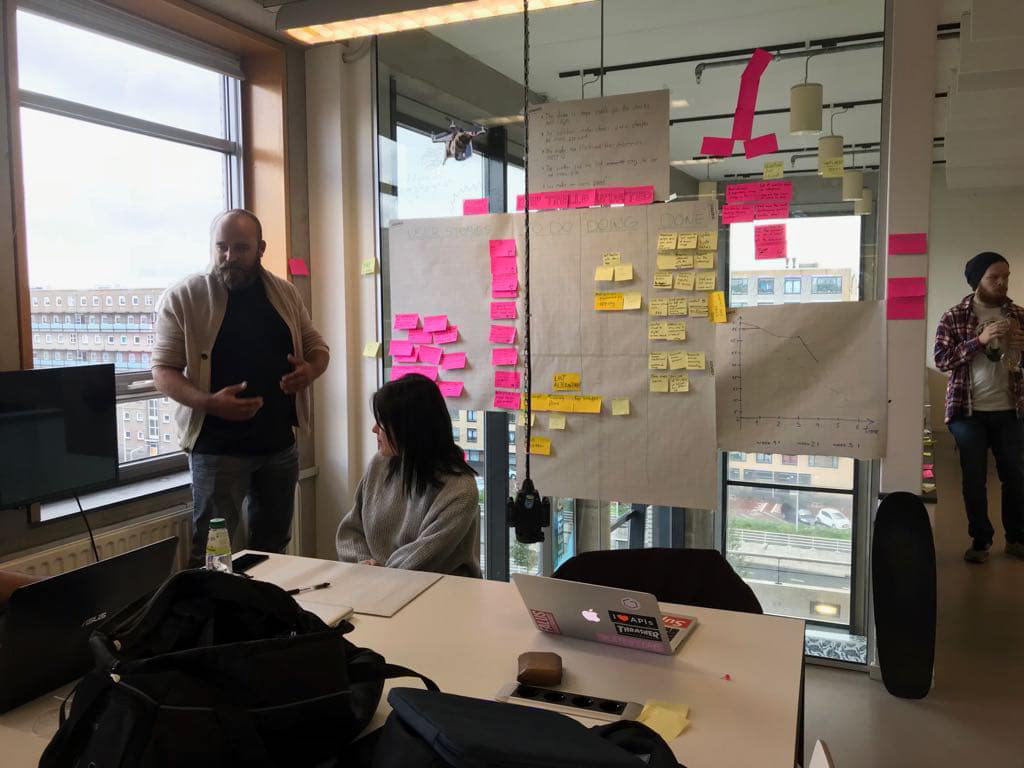
Sprint Scope Estimate
Total amount of points to burn: 89
Time: 3 weeks
Product Backlog
1. As designer I want to know what the current app lacks and does well.
2. As a client I want the concept to be safe for people and not a legal hustle.
3. As a UX Designer I want to know what current demo features exist/what are they capable of.
4. As a UX Designer I want to know alternative ideas instead of drone.
5. As Gemeente I want to make maintenance process cheaper using technology.
6. As a client I would like to see concrete info and updates on the development of the concept.
Sprint Goal
To figure out what characteristics and how feasible it would be to use a drone to automate maintenance checks in the city of Delft.
Sprint Outcome/Experiential Prototype/Research
1. Interview Script
Introduction:
-Names
-Purpose of the interview: To dive deeper into what is going well in the current situation and what could be better. To discuss details of importance for our concept and to gather thoughts on what we have gathered so far.
-The interview will be recorded for research purposes, are you okay with this?
-Offer a drink and get to it!
Remember:
-Maintain eye contact, keep a conversation flowing and record the interview rather than getting lost in note making.
-Thank the interviewee and offer him the opportunity to ask some questions in return.
-Don’t be afraid to dive deeper into what the user is saying and improvise!
Topics & Question list:
-Do you have any questions about the scrum board or approach?
-Could you introduce yourself and explain what your function is within the municipality of Delft?
-Drone connected to app, semi autonomous, equipped with sensors and ask what the client’s opinion is about the concept? What do you like about it? Is there something for which you feel a bit of doubt?
-Has the municipality of Delft ever worked directly or indirectly with a similar project which involved drones? IF NOT then mention research findings and ask how open would they be for a third party collaboration? & if we do contact these third parties WHAT information can we share with them? (most of them are in TU Delft, or Delft technology park)
-The legal implications of drone usage in the Netherlands are *explain them* Do you think this is something to worry much?
-Could you explain the journey of the quality check as a whole? Starting from your perspective, how involved are you in the process, then as the worker that does it and finally the communication with the contractors.
-How would you categorise the public areas that have to be checked?
-What are the most challenging quality checks at the moment?
-How are checks done in stormy weather?
-The price for drones range from 30 to thousands, is Gemeente Delft willing to invest in this concept and what would they need to see to give such an investment a green light?
-We can also rent just for demo purposes (remove if not necessary to mention)
€ 35,00 voor de eerste dag
€ 29,00 per extra dag
€ 175,00 per week
-Would it be possible to arrange a meeting with a person that does these checks in order to join them for a while while they do these checks?
Finalising the interview:
-Thank you statement: thank you for your time, you have provided us with a lot of information and insights
-Explain what happens now: Analysing and discussing interview.
-Remind him about getting us into contact with a person that does the checks.
Goals of the interview:
Get a drone start working.
2. Research on Drones
Debrief to Client/Retrospective

Prioritized Backlog

Burn-down Chart
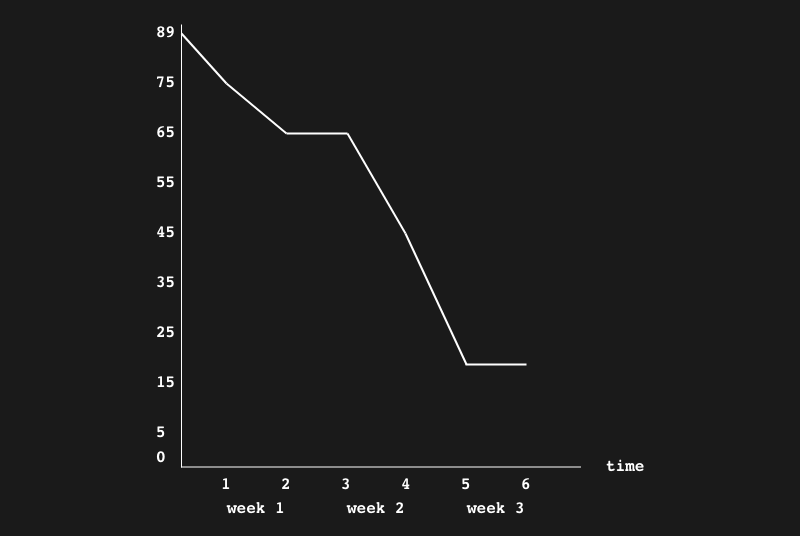
Sprint 2
Definition of Done
1. The new concept is feasible and works
2. The solution makes checks easier, cheaper and more effective
3. The workers find the tool easy and more fun
4. We make mommies proud
Scrum Room Setup

Sprint Scope Estimate
Total amount of points to burn: 48
Time: 4 weeks
Product Backlog
1. As a citizen I want to be involved in city’s maintenance process.
2. As a public area I would like to easily see the progress of the quality check (live).
3. As a public area I want the dashboard to have modes fitting current needs (location).
4. As a public area I want to validate dashboard/public area input easily.
5. As a public area I want to give a score to what I see (daily).
6. As a public area I want to provide updates through image recognition of trash cans.
7. As a public area I want to use AR to assist the quality check.
Sprint Goal
To make a feasible product, which will work in real life and be able to perform specific task: image recognition. In addition, to design a prototype of a dashboard.
Sprint Outcome/Experiential Prototype/Research
1. Interview script with Maintenance person
Introduction:
-Names
-Purpose of the interview: To dive deeper into what is going well in the current situation and what could be better. To understand fully what is liked and disliked of the current way of doing the quality check. To gain insights from the perspective of the person responsible for the quality checks.
-The interview will be recorded for research purposes, are you okay with this?
-Offer a drink and get to it!
Remember:
-Maintain eye contact, keep a conversation flowing and record the interview rather than getting lost in note making.
-Thank the interviewee and offer him the opportunity to ask some questions in return.
-Don’t be afraid to dive deeper into what the user is saying and improvise!
Topics & Question list:
-Could you introduce yourself and explain what your function is within the municipality of Delft?
-Could you explain the journey of the quality check as a whole? Starting from your perspective, how involved are you in the process? Who do you communicate to? And how does this communication takes place?
-How would you personally categorise the public areas that have to be checked?
-What are the most challenging quality checks at the moment?
-How are checks done in stormy weather?
-Could you explain briefly what the difference is between the different quality checks? What is unique about each?
-Do you find this task boring or fun in a way?
-Do you think the quality checks take too long and are a lot of work?
-What do you think of the app that you use for the checks? Did you find it complicated at first? And how about now?
-Ask what the worker’s opinion is about the concept? What do you like about it? Is there something for which you feel a bit of doubt?
Finalising the interview:
-Thank you statement: thank you for your time, you have provided us with a lot of information and insights
-Explain what happens now: Analysing and discussing interview.
Goals of the interview:
Get insights in worker’s perspective of the quality checks.
2. Wireframes
Debrief to Client/Retrospective
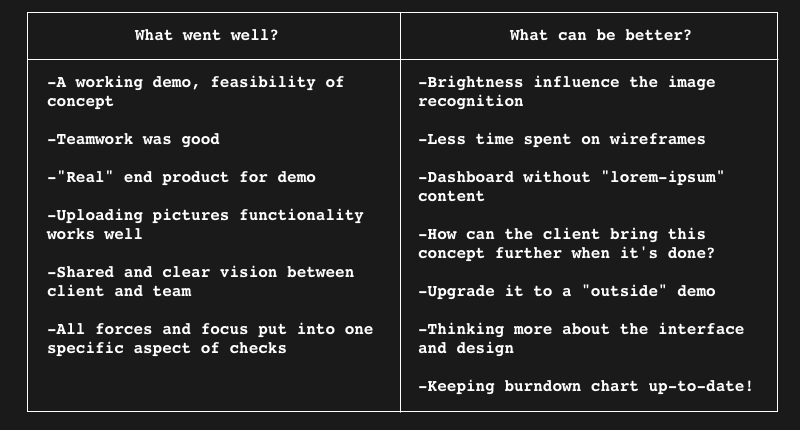
Prioritized Backlog
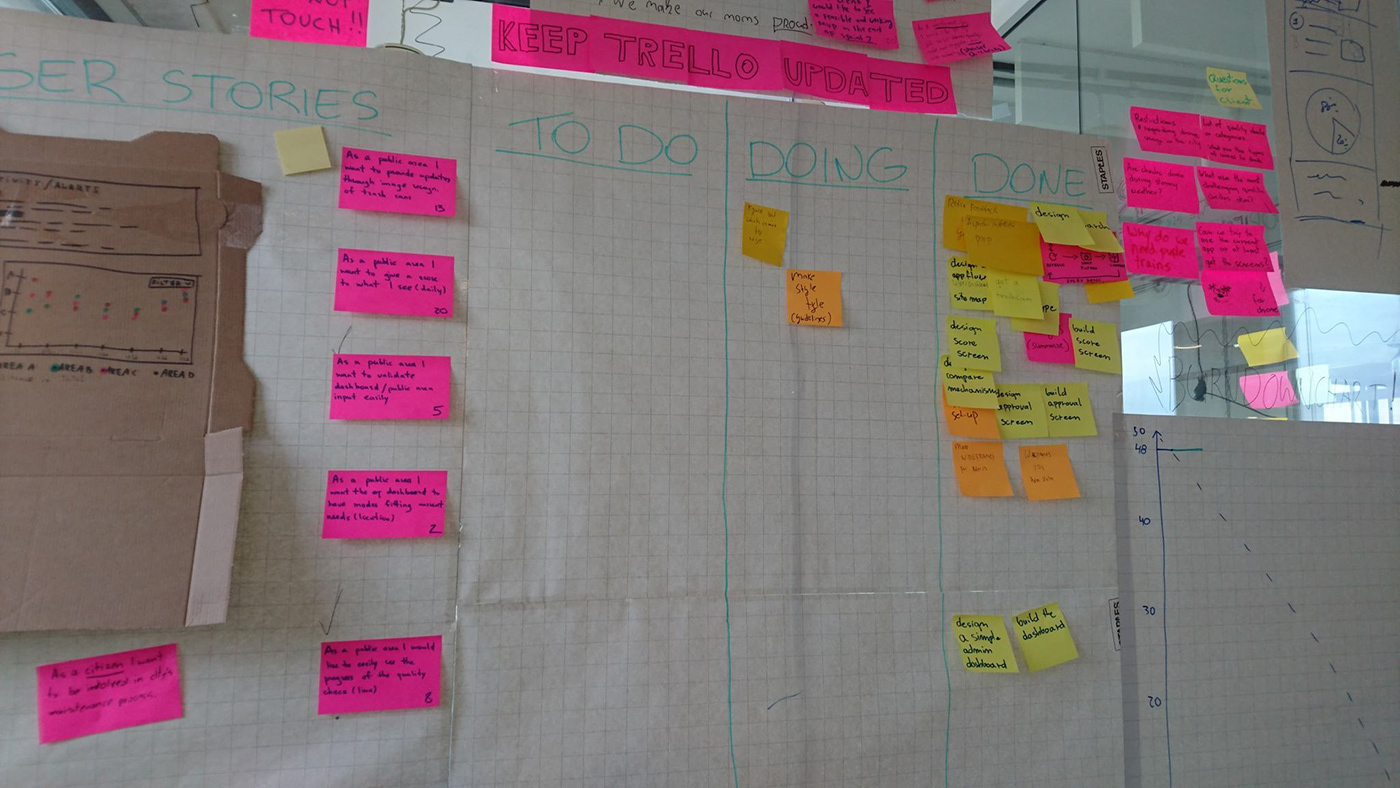
Burn-down Chart

Sprint 3
Definition of Done
1. The new concept is feasible and works
2. The solution makes checks easier, cheaper and more effective
3. The workers find the tool easy and more fun
We make mommies proud
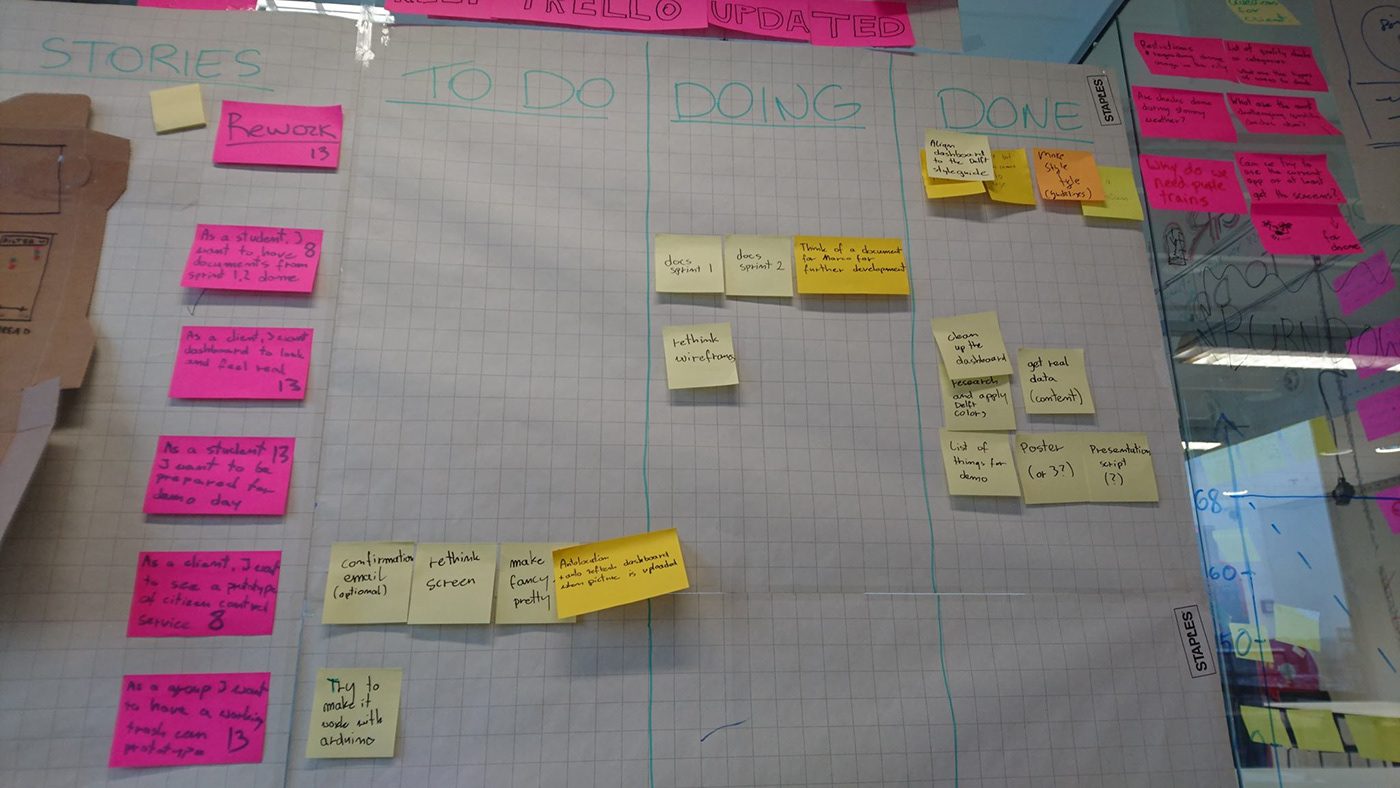
Sprint Scope Estimate
Total amount of points to burn: 68
Time: 3 weeks
Product Backlog
1. Rework
2. As a student, I want to have documents from Sprint 1 and 2 done.
3. As a client, I want dashboard to look and feel real.
4. As a student, I want to be prepared for demo day.
5. As a client, I want to see a prototype of citizen control service.
6. As a group, I want to have a working trash can prototype.
Sprint Goal
To make a dashboard more “polished”: make it in colours and style of Delft, use real information. In addition, improve our image recognition and power of the crowd function.
Sprint Outcome/Experiential Prototype/Research
1. Document for further development
Automated Quality Check: Future Steps
The result of the collaboration between Gemeente Delft and our group has resulted in a working prototype of an automated maintenance check concept. This concept uses HTML, CSS and JavaScript in order to simulate the work of a image recognition software. What was attempted to be shown is that with the necessary technical skills what seems to be a very complex solution can be simplified.
The basic idea of this concept is that a stationary camera will be overlooking the hotspots in the city of Delft. These hotspots are usually places in which the city of Delft invests a lot of money making sure they are up to standards and are checked on an almost daily basis. The camera should have access to a database in which it has access to images of the “perfect scenario” situation of the hotspot that it is keeping watch over. These perfect scenarios would represent an A+ score. As soon as trash is overflowing in these areas the system should compare the image of the perfect scenario with the current state, calculate a percentage difference and translate this into a score.
At the moment the concept has a structure based on the previously mentioned programming languages. The next steps in order to take this forward should be:
Program with legit image recognition software.
Test if the use of algorithms and AI are suitable or even necessary to provide the desired automation.
Test it in real life locations and under dutch weather conditions.
Step number one can be achieved by the strong technical knowledge capabilities of TU Delft. This is a challenge that seems to be perfect for students to be able to apply their knowledge and creativity. There are companies that offer and use tools powered by AI for image and video recognition purposes such as https://clarifai.com. The previously mentioned company offers an established digital infrastructure in packages which can save up the time to create a working product by half.
Step number two follows step number 1. These algorithms and teaching an AI about the different types of situations can take some time. By putting these assumptions to the test they can be ruled out or accepted as the way to go before putting too much money or effort into them. Maybe AI is of great value but a very complex algorithm with endless amount of variables isn’t? Or vice versa?. Taking an iterative / lean approach for this can prove to be very efficient and valuable.
Step number 3 can be achieved with some good planning and also by a small investment in more powerful gear. A camera that is resistant to the harsh weather conditions and that can be placed at a long distance and height from the hotspots is recommended.
The requirements for the challenge:
-System that measures the quality of the public space automatically instead of manually. And gives a score based on the percentage difference between current state and “perfect scenario”.
-Image recognition that is not affected by elements such as brightness (time of day) and differentiates between trash and people passing by when images are taken.
-Provide accurate advice for the city area based on algorithms and not human (inter)action. And also learns based on the data that it is being fed.
-Needs to daily or periodical check the quality and condition of the public hotspots
-Long-term check.
Debrief to Client/Retrospective
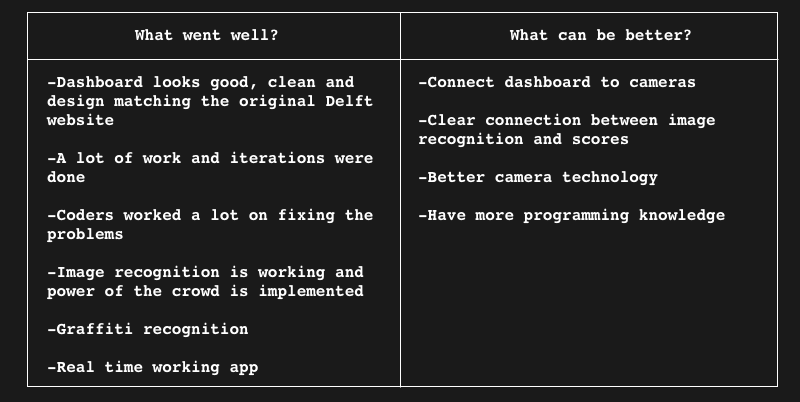
Prioritized Backlog
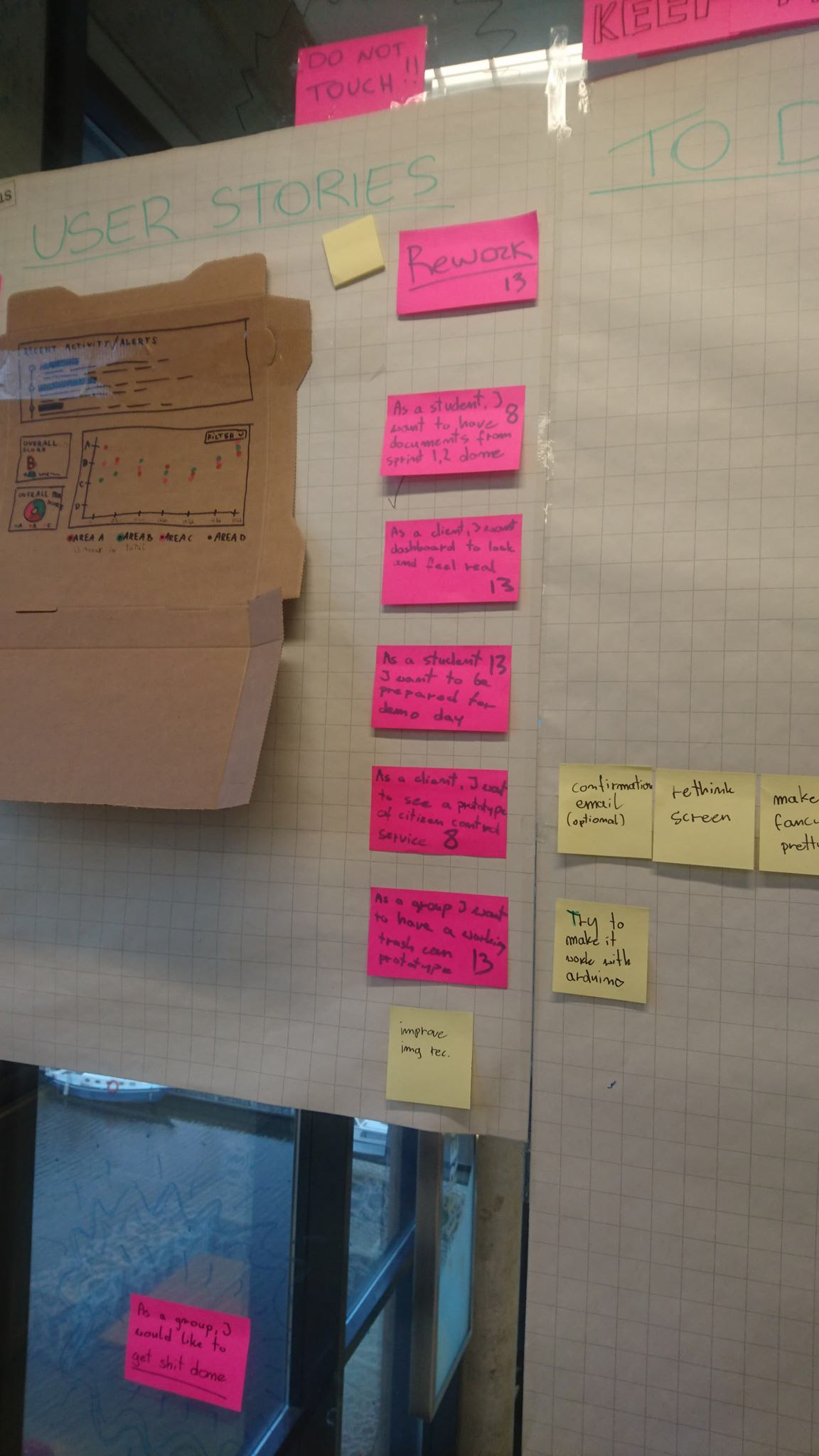
Burn-down Chart
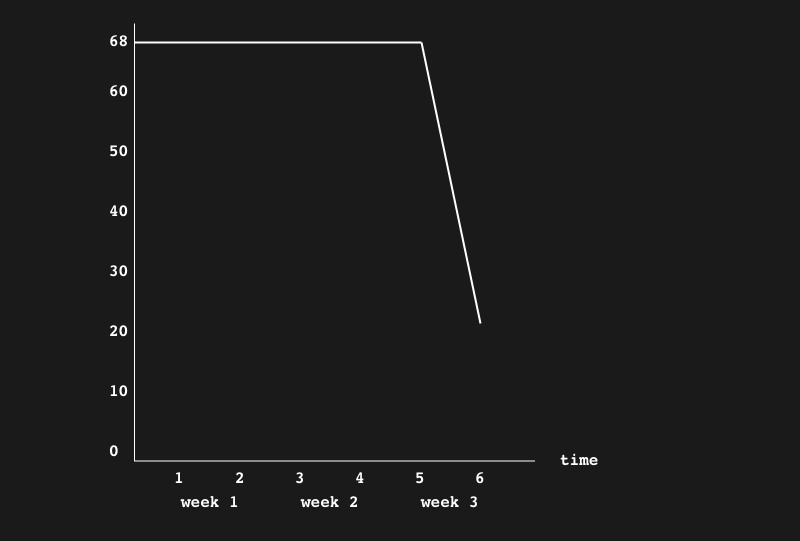
Final Product


